Ronit Seter (following, among others, Benjamin Bar-Am) grounds her in-depth study of Israeli art music in a general interpretation of its periods through the dialectical prism associated with Hegel: thesis, antithesis and synthesis.[1] The “thesis” is the Mediterranean style that dominated Israeli art music in the generation of the founders and that was accepted as a musical representation of nation building. The works composed in this style were based on an expanded modality, which includes a central note and an irregular dose of remnants of functional harmony. The level of modernity in the main works of this generation was relatively very moderate. As I see it, from an international perspective, the music of the “thesis” is a local branch of wide global trends. It was identified not only with the orientalism often mentioned in the Zionist context, but also with Neo-Classicism, Social Realism, and “Utility Music” (Gebrauchmusik) ala Hindemith.[2] To a certain extent, the Mediterranean style also had ties to Israeli popular music of the period,[3] but even in Israeli concert pieces with an especially pronounced popular feel to them (such as Menachem Avidom’s Folk Symphony) there are frequently dissonances of a kind that is foreign both to music of the tonal era and to the Israeli folk songs of the time.
The “antithesis” music, which came as a reaction against the music of the generation of the founders, expressed, to my understanding, a shift from loyalty to what was seen as the spirit of the nation (Volkgeist) toward a more marked loyalty to the spirit of the times (Zeitgeist).[4] The “antithesis” was expressed in the works of composers who started writing in modern and far more avant-garde styles, such as electronic music. For some composers, like Menachem Avidom and Jacob Gilboa, the stylistic shift between the different musical loyalties was so sharp that it seems to have threatened their personal stylistic identity. It should be noted that this shift to the modernist phase was also not unique to Israeli music. For example, Elliott Carter, who wrote his first compositions in a Neo-Classical style, shifted to an avant-garde style relatively early.
According to the thesis–antithesis–synthesis framework, Israeli art music could have combined the style of the founders’ generation with modernist elements only after it had experimented with clear modernism. However, alongside a revolution from thesis to synthesis there was also a process of gradual change (evolution) towards modernization in Israeli art music. This process was visible in the early 60s before the great exposure to European post-war Avant-Guard, and therefore it is inexact to see its products as a “synthesis.” The process of gradual modernization also has its equivalents in world music literature. For example, Alexander Skryabin started out as a tonal composer under the clear influence of Chopin and eventually reached a truly atonal style, but without developing a “split musical personality.”
This article focuses on the first movements of two exemplary Israeli string quartets from the early 1960s, Summer Strings by Tzvi Avni (1962) and Psalms by Ödön Pártos (1960). The two works are definitely modern and dissonant, and yet they still preserve a lot of the “Israeli” style. The historical circumstances behind the composition of the two works show that they do not embody a synthesis between fully formed contrasts, but rather a process of the internalization of modernism within the style of the first generation. Understanding this historical moment in Israeli music and the different trends involved is fairly trivial; understanding how the combination between modernism and what is perceived as “Israeliness” is realized in these quartets is a far more complex challenge.
# Summer Strings: The Opening Theme and its Later Development
At first sight, Tzvi Avni appears to be one of the composers whose artistic development could clearly be interpreted according to the thesis–antithesis–synthesis model. Michael Wolpe describes three periods in Avni’s work that fit the three categories described above: Avni started off composing works in the Mediterranean style (e.g. Three Songs from the Song of Songs); during his stay in the US in the 1960s, a clear Modernist influence started appearing in his work (e.g. Meditations on Drama); and in his later works, while Avni does preserve the modernist spirit, his compositions become more conservative and his musical language becomes closer to tonality.[5]
While this description is generally accurate, it is insensitive to how Avni’s motivation to study in the United States was born out of the desire to get to know the musical innovations taking place in the wider music world. Moreover, his work on the eve of his departure to the United States, prior to the break between thesis and antithesis, had already ventured far beyond his first mature works. A central and exceptional work that represents the gradual modernization of Avni in the framework of the Mediterranean School is his first string quartet, which was published as Summer Strings. Avni later wrote that he had composed the work in 1962, ahead of a composition seminar taught by Ödön Pártos at Beit Daniel, and that he retrospectively saw it as the end of his first period, “in terms of both the technique and the style, which had formed into something clear and well-defined.”[6] Although Summer Strings was grouped together with the works of the first period, Avni was definitely aware of the fact that the piece had heralded his next creative phase: “the departure from the impressionistic elements of the Mediterranean School is apparent, and so is the development of musical thought with ‘sonoric’ elements, which would eventually lead me to electronic music.”[7]
In his general remarks on Summer Strings, Avni points out that it embodies “folkloristic elements, a tense harmony that results from heterophonic writing, chords that sometime consist of eight or nine notes, and resonances and rhythms that might have been influenced by Mordechai Seter… and Bartók.”
Regarding the choice of musical form, he wrote that at that period he used mainly classical forms, and at times incorporated fugatos. There appears to be a clear key to understanding how the piece sounds both modern and “Israeli”: the harmony is responsible for the modernity, and the motives are responsible for the Israeliness. This is an oversimplification. The quartet is not uniform. This mixture is recognizable from a number of works by Bartók (such as Out of Doors): certain movements (in Summer Strings, the third movement and the beginning of the fourth) are abstract and modernist and do not try to remain tied to traditional anchors at all. These are entwined between movements in an expanded tonality. By contrast, the first movement enables a balance between tradition and innovation in quite an interesting way.
The following analysis of the first movement tries to closely examine its style while paying special attention to the development of the opening thematic material. The form is not particularly daring, but it also does not fall into a predictable scheme as one might expect from Avni’s words. The detailed analysis is also an end in itself, and not just a tool in service of a discussion about the work’s historical role.
# Summer Strings: The Form of the First Movement
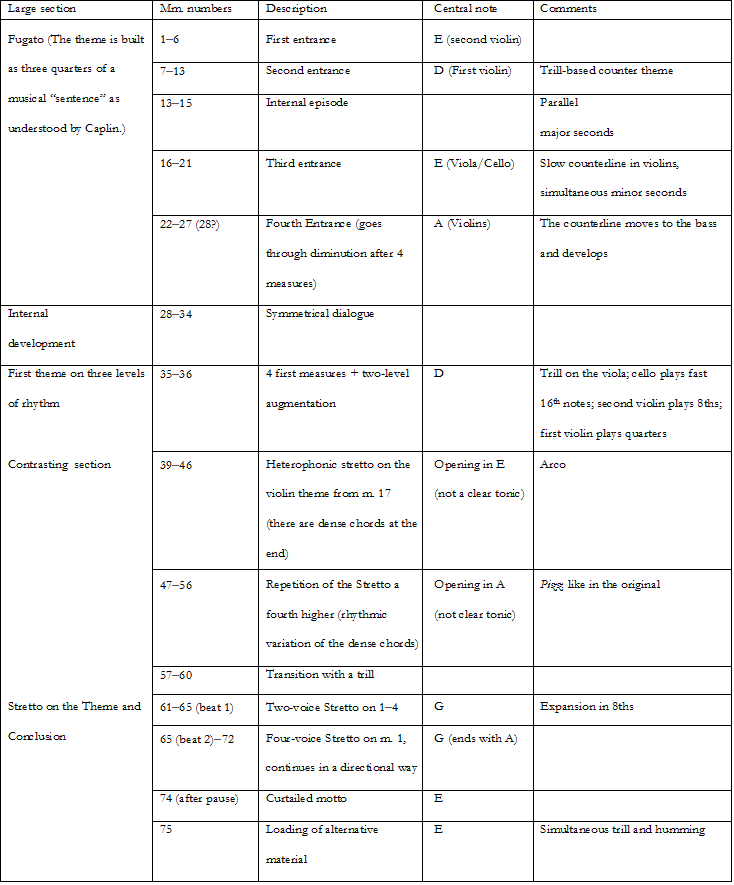
# The Theme of the First Movement
The first movement starts with a fugato on a long theme. By the second entrance there are six measures, which are built on a pattern of two measures, a rhythmic repetition with a change in the tones, and then two repetitions on the thematic material of the first measure alone (see example 1). This pattern fits the first three quarters of what is known as a musical “sentence.” This structure in its full form lasts for eight measures: a four-measure presentation of the material, which consist of two measures of the basic material and two measures of repetition of the basic material (not necessarily an exact repetition); two measures that give a sense of continuity and are usually based on fragmentation into short one-measure units; and a two-measure ending that concludes with a cadence.[8] In its clearest manifestations, it is a kind of musical limerick, in which the two shortest lines (the third and the fourth) have the length of a long line. The “sentence” is one of the two basic prototypes of phrases in the classical era, but unlike the other prototype (the classical “period”), the structure of the musical “sentence” is applicable to music in which the functional harmony is weak (as it is in Nocturne No. 4 by Poulenc) or almost absent (as it is in Skryabin’s Poëme Op. 59 No. 1). In the pieces just mentioned, it is possible to see the excessive squareness of the phrases as an aesthetic flaw and as an example of a mismatch between the form and the musical content. But in Summer Strings the squareness is very moderate. First of all, although the first idea has two measures, each one of them has five beats, not layers built on regular duple units. A more important factor in the weakening of the squareness of the opening “sentence” of Summer Strings is its abrupt ending after only six measures. The phenomenon of the abruptly ended musical sentence has been detected as far back as music of Beethoven[9], but in Summer Strings the realization of the abruptly ended sentence is even more distinct: after six measures of an unaccompanied second violin—which distinctly include two measures of a basic idea, two measures of repetition, and two measures that split the original idea—the first violin enters and starts what is clearly a new phrase.
The opening melody, which will return several times during the movement, is built purely on steps, and only in one place a half tone is notated as an augmented prime (D sharp/D natural) in order to avoid writing a C double-sharp that doesn’t lead upwards. The melody is very chromatic and uses all twelve tones of the chromatic scale (except for the note C) already in the first two measures. However, every note could be seen as a scale step relative to the central note (E, which is also the opening note; initially A can be seen as an alternative central note). Therefore, the melody fills an important, but not sufficient, requirement of tonality: a central note that the other notes are perceived in relation to (Centricity).
The opening melody, which will return several times during the movement, is built purely on steps, and only in one place a half tone is notated as an augmented prime (D sharp/D natural) in order to avoid writing a C double-sharp that doesn’t lead upwards.
Dmitri Tymoczko (2011, 179) explains the concept of centricity. He tries to break down the idea of “tonality” into its elements in order to organize the understanding of different practices (in early music, Wagner, twentieth-century concert music, jazz, and progressive rock) which share several characteristics of full functional 18th and 19th century tonality, but not all of its components.[10] One of the components that Tymoczko defines is the existence of a central note, based on seven elements: frequent appearance, length, dynamic accent, rhythmical accent (in fact, metrical accent), melodic climax in the register, a goal for melodic stepwise movement and doublings. In fact, although these elements generate conspicuousness, the attempt to define them as the reasons for a tonic-like feeling is completely unfounded. Clearly functional music can contain foreign climactic notes (dissonant, neighbouring or passing notes that have gone through free register realization) that are stressed, continuous, and doubled and which are more frequent than the tonic. Among all the elements mentioned, the only one that supports a central note in Summer Strings is metrical accent.
Avni’s music counts as tonal music in the expanded sense presented by Eitan Agmon, since all the sounds are notated and function as primary intervals (not augmented or diminished) relative to the base note E.[11] Example 1 compares the motto as it is to hypothetical diatonic versions in E major and E minor (the second note of the theme, half a tone above the home note, is in the Phrygian mode). The chromatization of diatonic melodies (real or hypothetical) is a well-known effect, which is featured, for example, in the works of Charles Ives, but the aesthetic effect in Avni’s work is quite different and could be seen as more “noble.” Ives distorts known and usually arpeggio-based melodies, and this serves as an ironic method of opposing the coherence of the whole.[12] In Summer Strings, in comparison, the diatonic basis is all in steps, and the chromatization serves the purpose of forming the coherent whole of a unified style.
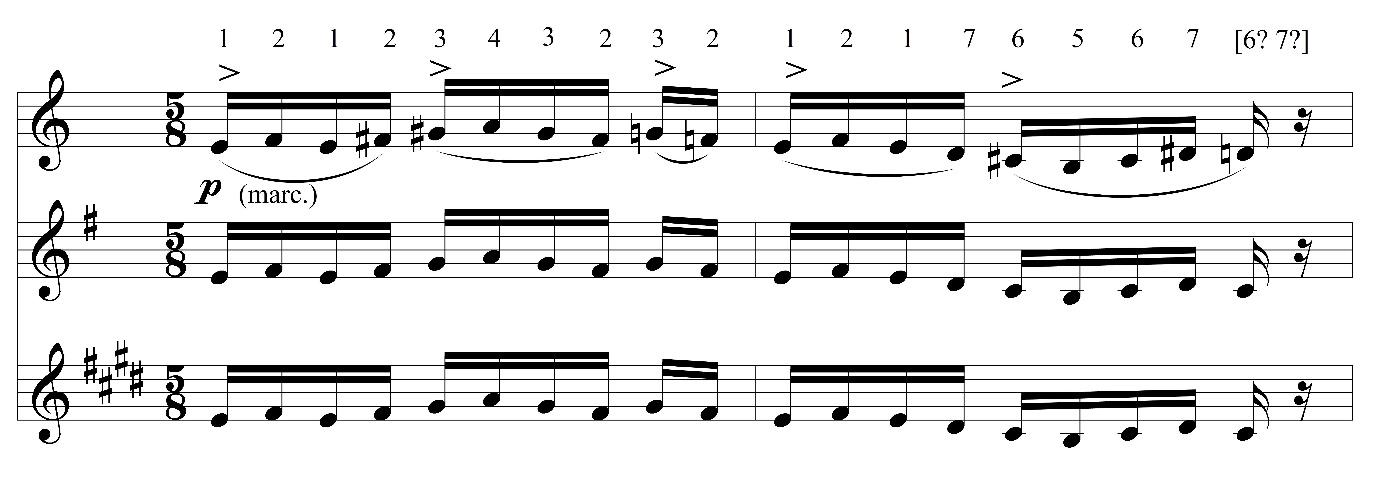
The general contour of the melody creates unequal waves. Between mm. 1 and 2 there is a general reflective symmetry: in m. 1 the melodic line goes up to A and the goes down, whereas in m. 2 the line goes down and then up. In both directions, the total range is a fourth whose extreme note functions as a neighbor note (A is an upper neighbor note to G-sharp, B is a lower neighbor note to C-sharp). That being said, the beginning of the measures creates a transposition symmetry (the first three sounds in the measure are identical to their equivalents in m. 2). Additionally, in every measure there is a reflective symmetry in the general direction, but the melody avoids a schematic inversion. Example 2 shows how an exact inversion of the ascent or descent in m. 1 would have looked like.
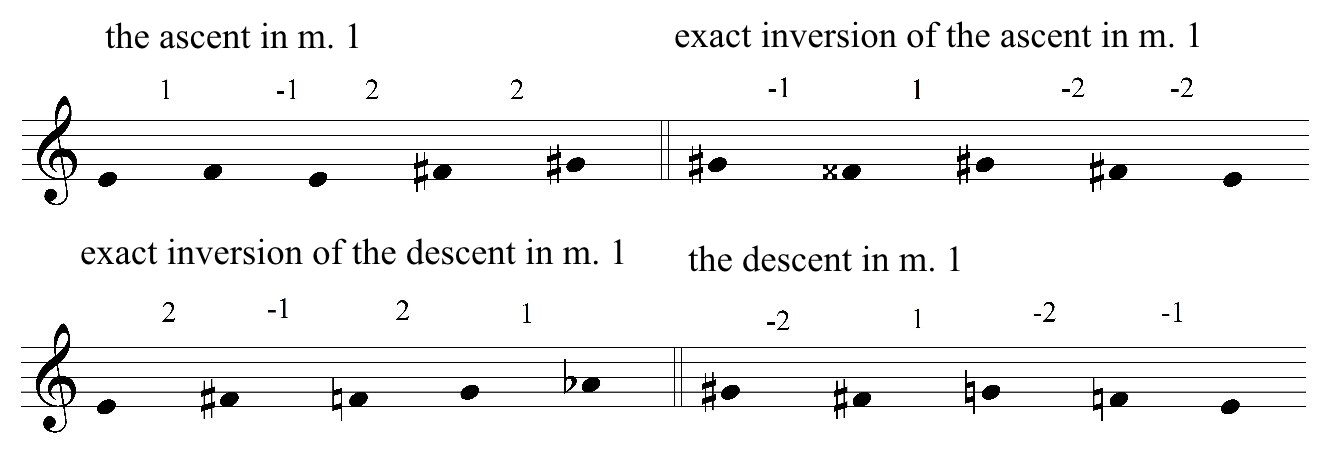
An exact inversion of the ascent (as long as the E serves as a kind of tonic) would create a chromatic ornament to the major third. Such an ornament appears, for instance, in Chopin’s Nocturne Op. 9 No. 3 and is also typical of operettas and American musicals (such as Irving Berlin’s Easter Parade) but is completely foreign to the spirit of Summer Strings. An exact inversion of the descent would create a different divergence from the one needed, since the third note (half a tone above the opening sound) would not be received as a variant of step 1, and so there would be a substantial difference from the descent despite the mathematical inversion.
It is interesting to compare the motto to the fugato theme in the third movement of the Ricercar for Strings composed by Avni’s teacher, Mordecai Seter. This piece, which was composed for a string orchestra and also has a string quartet version, most likely served as a model for Avni. Seter’s motto (played by the first violin only) also consists purely of single step movement (except for the diminished third C-A-sharp, a whole tone which is correctly not notated as a second) and contains constant diversity (see example 3). In this theme too, the basic unit is five notes, but the rhythmic flexibility is larger due both to the choice of beats of dotted quarter notes (divided into three) and to the lack of symmetry between the basic idea and its repetition (in the repetition there is an expansion into six beats). Additionally, the reference note, which sounds for a moment like a tonal home note, is not constant: initially the potential home note is the opening G (the hypothetical variant in the example shows how G could function as the home note), but the F-sharp, which is the lowest and longest in m. 1, becomes the reference note in m. 2. Because of the differences of scale associations, Seter switched the enharmonic notation of A-flat (second scale step, half a tone above G) to G-sharp (second scale step and a whole tone above F-sharp).
In comparison to the theme of the Ricercar, the theme of Summer Strings does not look like a phase in the departure from the Israeli style toward modernism. On the contrary, it is an imitation of the style of Seter’s Ricercar by a composer whose cultural foundation is still closer to traditional modality. The historical position of Summer Strings after the Ricercar is therefore a step back in the route from thesis to antithesis, even if we do not adopt the teleological attitude according to which such a “regression” has negative value.
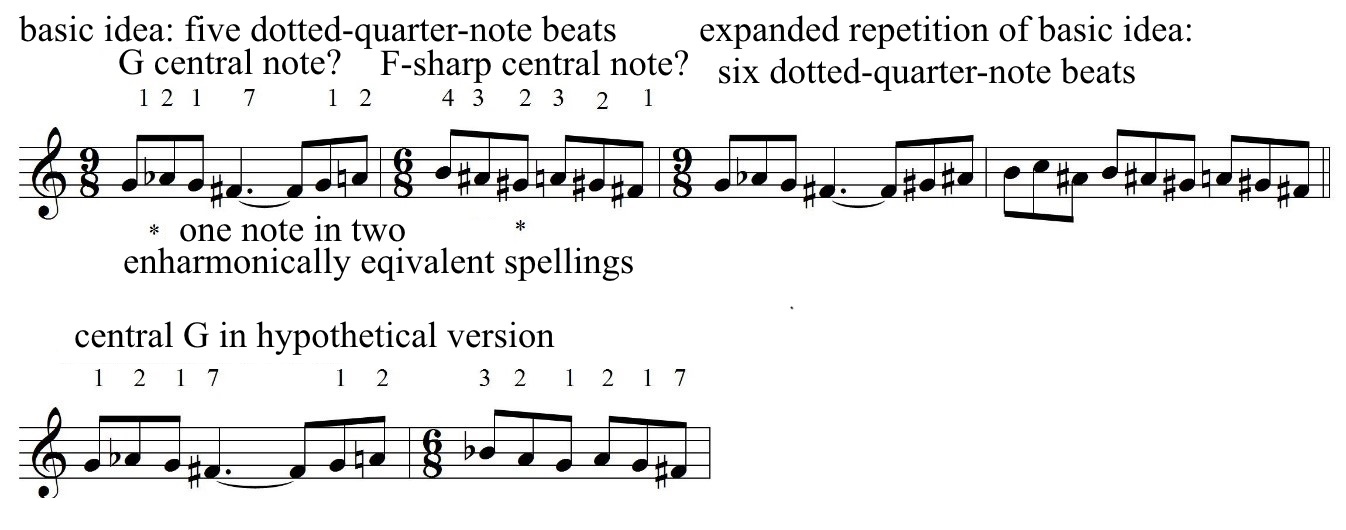
The first couple of measures in Summer Strings sound closed in comparison to the second couple of measures that are based on the same material. This phenomenon is common in tonal music (like in Mendelssohn’s Song Without Words Op. 102 No. 2, where the first phrase ends with a perfect authentic cadence in the tonic and the next phrase starts with the same material but modulates) and in popular songs. It is not easy to achieve a similar effect without functional harmony and without a cadence at the end of the first phrase. In Summer Strings, the first pair of measures does not end with an E or with another note from the same “chord.” Only the rhythm creates a stop and, melodically, the first ending gives a sense of closure due to its proximity to the starting point and even releases tension after the descent. The next pair of measures, in comparison, ends in an open way during an ascent.
M. 3 also has clear symmetrical potential, this time in the form of a sequence. Here too Avni avoids exact symmetry on the half-tone level, which would lead to an augmented or diminished fifth (example 4). The hypothetical pattern in the middle staff preserves all seven opening notes and continues consistently another major third, as if dividing the octave into three equal parts. The pattern in the lower staff preserves the chromatic density (without skipping the G natural during the ascent) and it continues consistently another minor third as if it were dividing the octave into four equal parts. In both of these systematic patterns, there are aesthetic deficiencies from the perspective of Summer Strings. A hypothetical symmetrical development would not fit well with the work’s asymmetrical meter and would necessitate the use of augmented or diminished intervals against E as the home note, even in notes that could be interpreted as “primal intervals" against E (B-sharp instead of C or C-flat instead of B).[13]
Additionally, an equal division of the octave would limit the possible notes on stressed beats (in a symmetrical meter into three or four notes cyclically) in a way that would clash with the work’s aesthetic ideal.
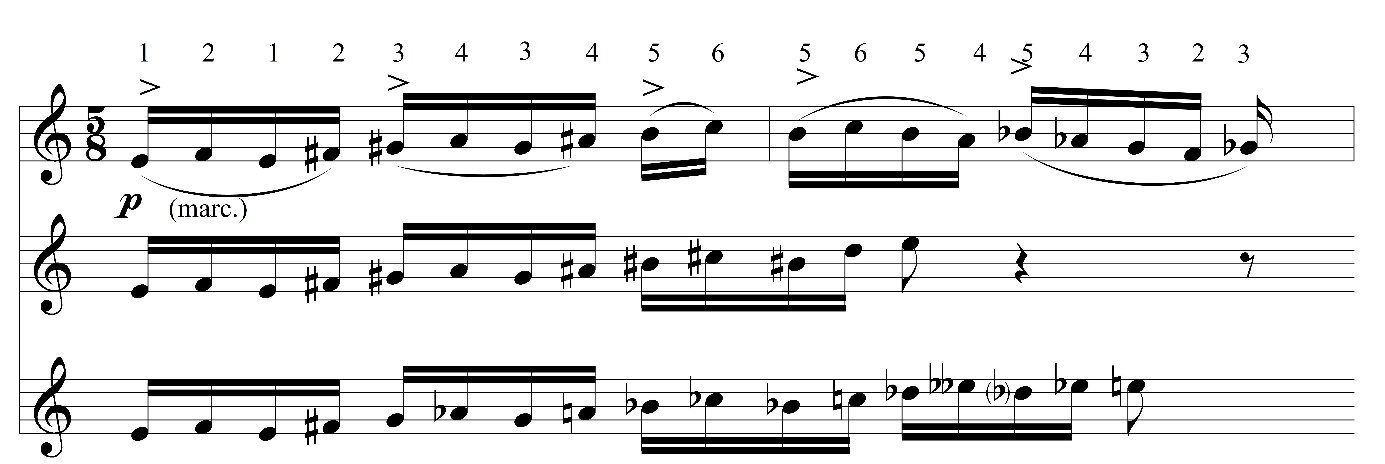
In the second entry (m. 7), the second violin continues with a “counter theme” and creates a completely different kind of “Israeli” and modern simultaneity. The new material is based on a trill that is performed against a melody in the same register, in which seconds generate passing tones in a traditional way. In the last pair of eights, in every measure the trill opens to a local ornament that is, in itself, perceived as an “Israeli” component, while in the inaccurate repetitions there is a chromatic diversity that thrusts the first notes into the level of the whole measure (example 5).
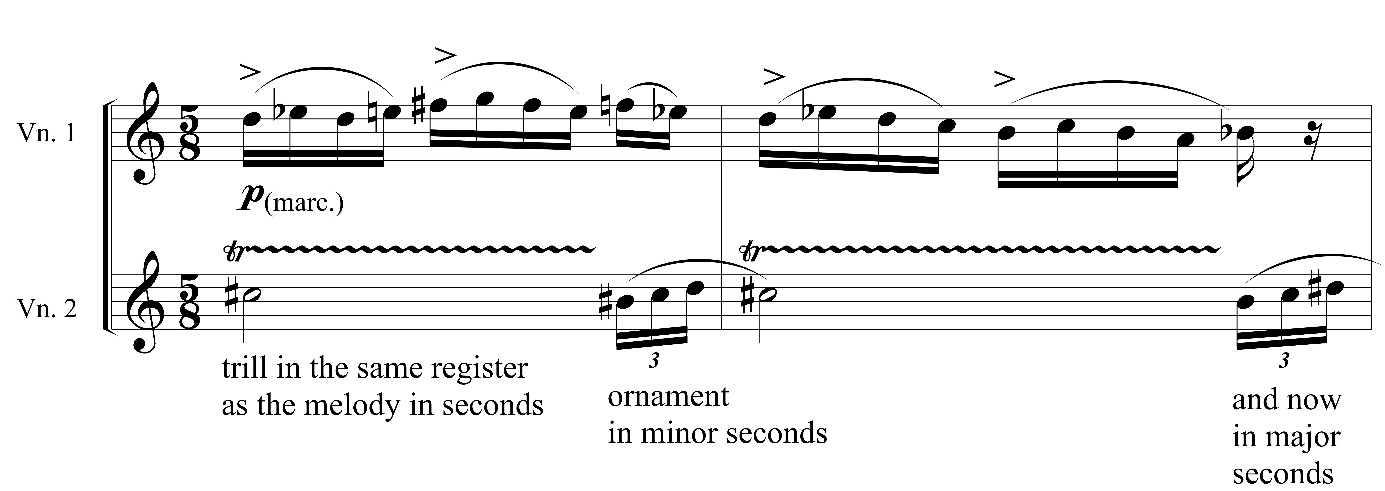
The combination of parts during the trills creates a clear dissonance, especially at the beginning of the trills: the trill notes C-sharp and D merge in a muddiness that does not fit with the imitative independent voices in the same register and timbre on the notes D and E-flat. The result is reminiscent of insect murmurs in a manner similar to “From the Diary of a Fly” in Bartók’s Mikrokosmos.[14]
Before the third entrance there is a transition that resembles an internal episode in the exposition of a traditional fugue, in which there is movement in parallel major seconds (like the consistent parallel intervals in the second movement of Bartók’s Concerto for Orchestra). The transition ends in an inward gathering (centripetal force) that is reminiscent of the end of m. 2, but this time in larger intervals in the melody and not in the dense chromaticism of the beginning of the movement. Unfortunately, this material does not appear again later in the piece.
Before the third entrance there is a transition that resembles an internal episode in the exposition of a traditional fugue, in which there is movement in parallel major seconds (like the consistent parallel intervals in the second movement of Bartók’s Concerto for Orchestra).
The third entrance also starts with an E (an octave below the first note of the piece), and one measure later the entire quartet plays together for the first time. Now there are three layers in the texture: the expanded melody shifts between the viola and the cello, while the other instrument plays filling that is dissonant against the texture. At the same time, the violins play a slower counter line, which shows a partial similarity to the main melody, especially the closing of the melodic line, that convenes in a melodic half tone in contrary motion to the whole tone that precedes it (in m. 21 there is a descent after an ascent like in m. 2; in mm. 17–18 there is an ascent after a descent).
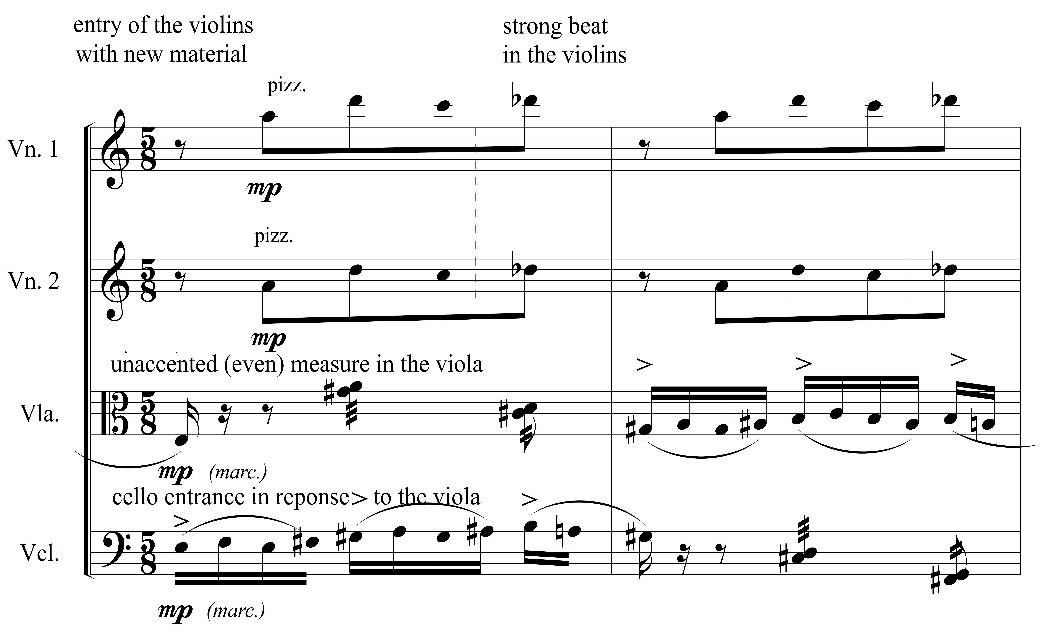
The entrance of the violins undermines the feeling of the meter on two levels: (1) On the level of the beats — the silence on the first beat in the violin part sounds like a continuation of the note that precedes it, as if the bar line has shifted back (see the broken vertical line I have added to the example). (2) On the level of the measures — in m. 17 the violins present new material that accentuates it as a strong measure, and in the lower instruments the accentuated measure is m. 16; although the cello also enters in m. 17, it plays a continuation of the main melody that started in the viola, in the same register. The long melody is based on the opening motto, and its details reveal inventiveness and constant diversity.
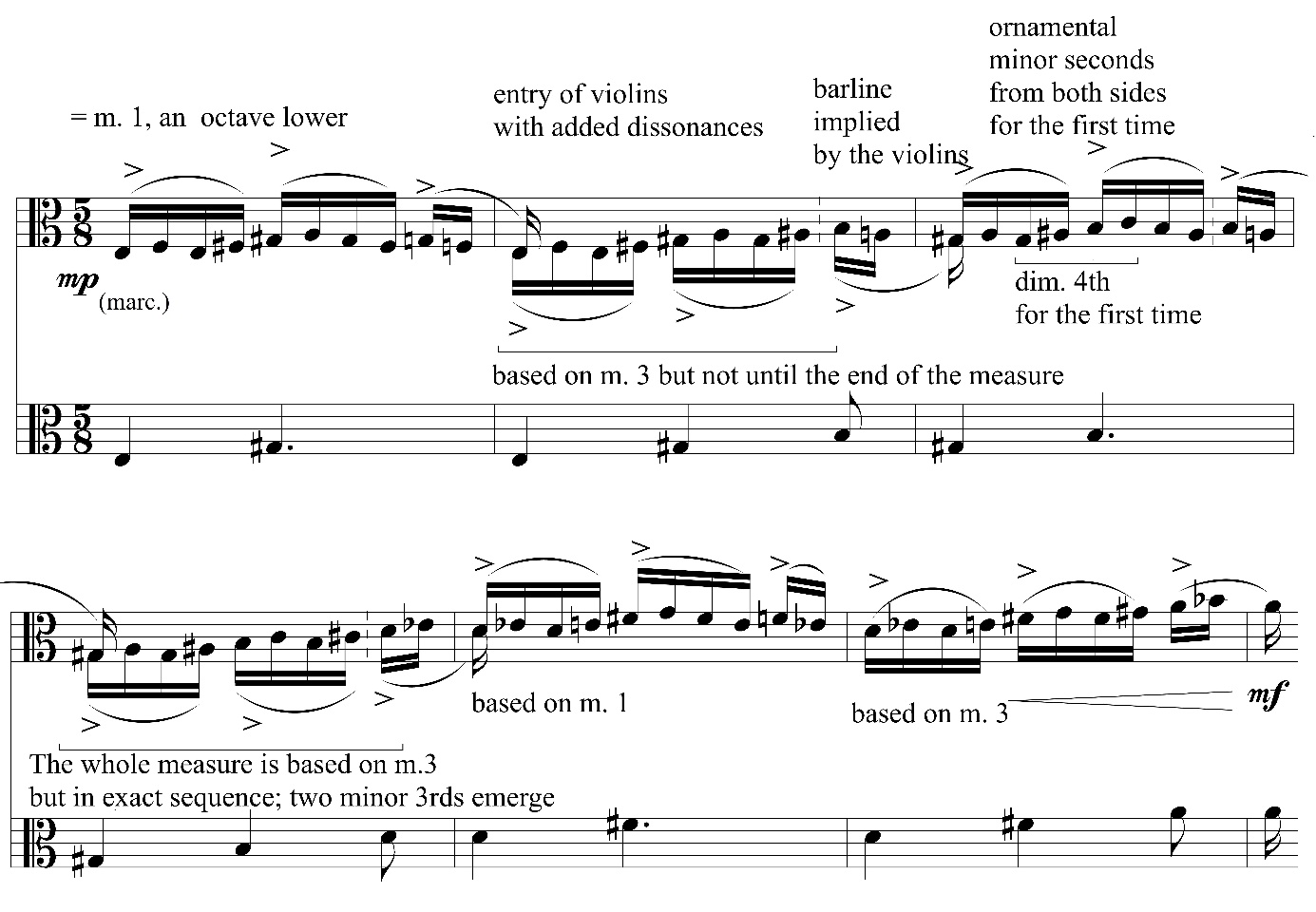
The division into two instruments enables a more flowing articulation, in which the short eighth-note unit at the end of the measures is tied with a legato to the next measure. Thus, the inter-instrumental articulation becomes conjunctive and not disjunctive. Although every measure in this unit is based on m. 1 (or m. 3, which is based on the same motive), three consecutive measures (18–20) show new variants. The essence of this unit in general creates an ascent by five thirds that add up to an eleventh (an octave + fourth) between quasi-tonic central notes: E at the beginning of the passage and A at the end. The details of the thirds avoid an exact cyclicality in order to continue the chromatic diversity and to reach a destination that is different from the starting point. The distribution of the reduction is also not uniform: after the ascent to B, the melody returns to lower registers, but in the next wave the melodic essence continues to push upwards (see the lower staff of example 7).
The division into two instruments enables a more flowing articulation, in which the short eighth-note unit at the end of the measures is tied with a legato to the next measure.
As for the musical language, which is between expanded tonality and atonality, it is interesting to discern between two moments: in one the exact enharmonic notation is important and in the other it is meaningless. In m. 19, the C natural creates (for the first time) a diminished fourth above the local anchor note (G-sharp). C functions as a neighbor note to the third, B, and the route to it from G-sharp is completely scale-based. This way the diminished fourth is notably distinct from the possible enharmonic major third interval (as it is between the first and fifth note in m. 1). Thus an identical amount of half tones (4) functions in two different manners scale-wise.[15] In comparison, in m. 21 the violins play the sequence B-D-flat-C (not in the example before you), whose notation gives the impression that this is a diminished third and its resolution. The same sequence could have been notated with a C-sharp, as a transposition of the sequence C-sharp-D-sharp-D-natural in m. 2.
The fourth entrance (m. 22, played by the violins) is more orderly, but after four measures (m. 26) the feeling of five-beat units (according to the bar lines) disappears because of the curtailing of the motives: in the violins, the main motive is divided into two three-beat units (six beats in total, including the accented beat of the next measure) (see example 8a). Similarly, the cello plays a sequence on a four-beat unit that is based on the material of the violins from m. 17, but without the downbeat. This material too, which has hitherto been played as an ostinato, now moves in a directional way as part of a large ascent (see example 8).


After a dialogue between the viola and the other instruments (mm. 28–34), the theme returns in its original fast pace in the cello, in combination with an augmentation into eighth notes in the second violin and into quarter notes in the first violin, played in noticeable flageolets. The augmentation is clear, but the details of the differences demand attention. The original theme in the cello is played in the exact same way as the original for two measures and then it repeats in a way that is directional rather than wave-like. The theme that is played by the second violin in eighth notes does not stop like it does in m. 2, but continues for two more eight notes until the strong beat, while in the quarter-note version played by the first violin there is, for the first time, an exact inversion. Unlike in the other appearances of the motto, this time the interval of a fourth that frames the melody is not based on a third plus a neighbor note, but rather on a filled fourth. The version of the melody in the violin could have fitted in a tonal setting to a melodic G minor (like in the motto of Beethoven’s Op. 95 quartet, in which the descent comes before the ascent), but here the general texture is dissonant, and, in fact, there is no traditional monitoring of the simultaneous events. The viola does not participate in the augmented imitation, but it does participate, like the cello, in the opening up of material that has hitherto curled around one note (the counter material from m. 7) into directional scale-based material.[16]
After a dialogue between the viola and the other instruments (mm.
[Text in Example: 4-fold augmentation, exact inversion; two-fold augmentation; this time without a trill; the fourth note this time is note a neighbor note, but a delineator of the framework; completion by the bar line; development of the Middle-Eastern curl into a scale]
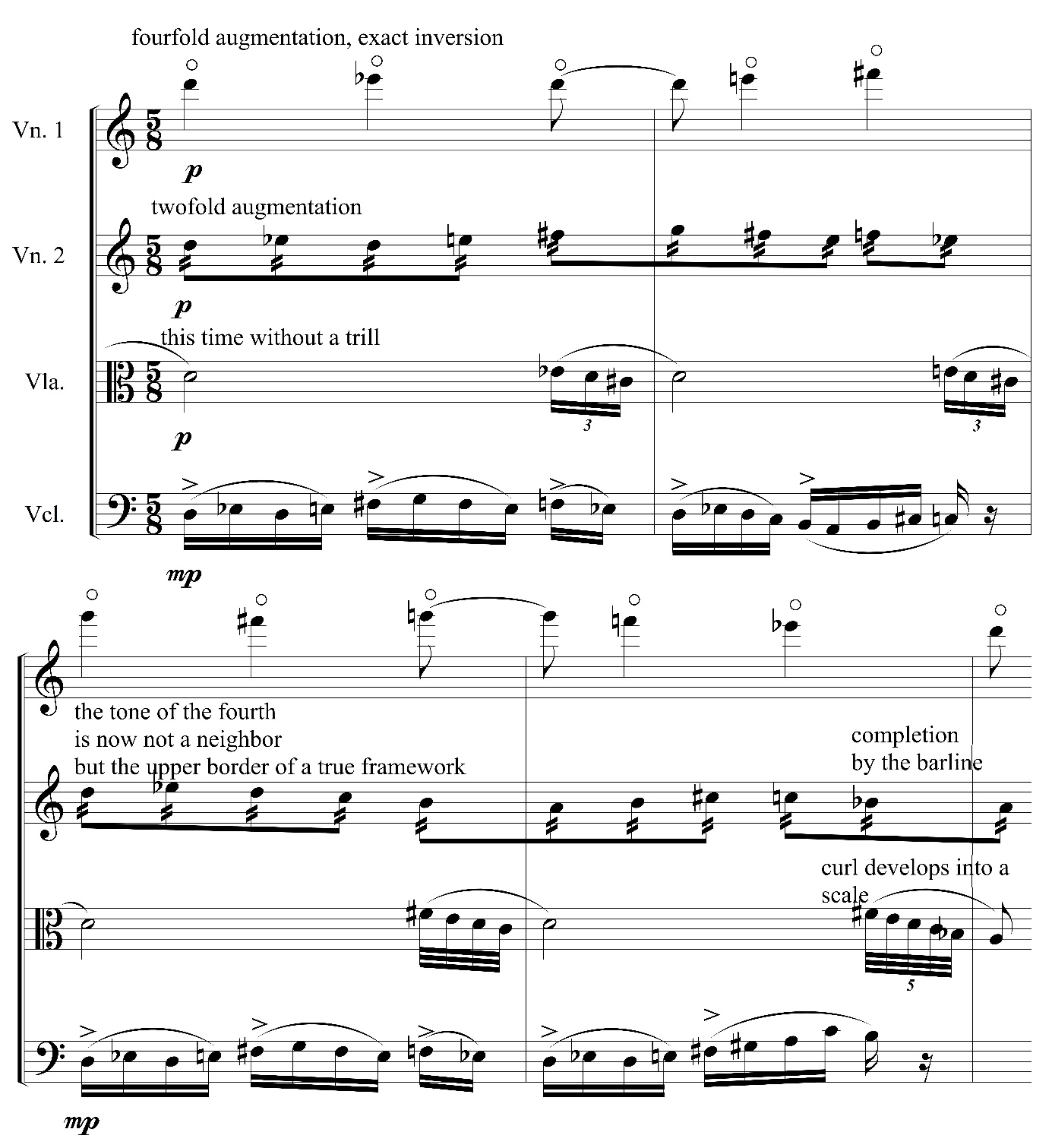
The contrasting section in m. 41 is a heterophonic stretto based on the slow material that was played by the violins in m. 17. Four instruments participate in a tight 5/8 canon, in such a way that in every measure there is one beat without a new entrance. This entire expanded unit occurs twice with the same order of entrances, first in separate notes played arco (all downward bow movements) and then in pizzicato. In both times, the violin is not present in the first series of entrances, but wiggles its way into the second series of entrances in the time gap that is created earlier (despite the canon). The effect is not muddy, because the instruments spread in a wide register. Additionally, there is no interval that is, de facto, smaller than a perfect fourth, and every instrument performs the identical pattern in another location in the scale. In the second time the fourth is played upward but includes an expansion, and the simultaneous chords in the end are in a slightly different rhythm. The whole section creates a dilution of the level of activity, unlike the normal aesthetic effect of a stretto. The very recurrence of the musical material makes the section sound like a unified whole.
After a short interlude with a long trill there is a stretto based on the motto. This is a good point to apply the conceptualization through the prism of thesis, antithesis and synthesis also to the internal structure of the movement: A stretto based on the movement’s motto creates a synthesis between the thesis (the motto from the beginning of the movement) and the antithesis (the stretto texture that was applied to counter material and that created a dilution of the level of activity, as described above). Above the home note (in this section: G) the theme returns, this time in a fuller manner until the fourth measure, in which there is a one-beat expansion (example 10).
[Text in the Example: The cello doubles two octaves lower; the first violin and the viola in an eighth-note canon; the third beat is inserted)

In this section there are two successive stretto processes: first there are instrumental pairs (two entrances), and then each instrument enters separately in ascending order, like a four-octave fan. In the second instance the melody, which is featured with dense imitation, is expanded and ends in an ascent. After one measure of a general pause, the theme returns to the original home note (E), although the movement does not feature an overarching functional tonal progression. After one measure featuring the motto, all the piece’s other materials are voiced together, simultaneously, over a pedal point played by the cello on the tonic: the first violin plays the trill in a way that diversifies and intensifies the ornamental curl in its end, the second violin hybridizes the muddy humming (a simultaneous minor second) with the ornamental curl (melodic minor seconds), and the viola repeats in ostinato the four notes that served as the theme for the stretto in the alternate section.
In this section there are two successive stretto processes: first there are instrumental pairs (two entrances), and then each instrument enters separately in ascending order, like a four-octave fan.
These phenomena are noticeable upon simple listening, and even more so after viewing the score. In contrast, the comparison of the different occurrences of the motto throughout the movement requires special attention. The opening motto recurs in many different forms. The core of the motto (a single measure) recurs many times, both as an exact replica and with various changes. Example 11 shows all the occurrences of the core of the motto and its various one-measure reformulations. In order to facilitate comparative analysis, all the versions were transposed so that they begin with E. The example does not include shortened occurrences of the motto (like in m. 2) and curtails variants of the motto that continue beyond the bar line (like the occurrence in m. 29).
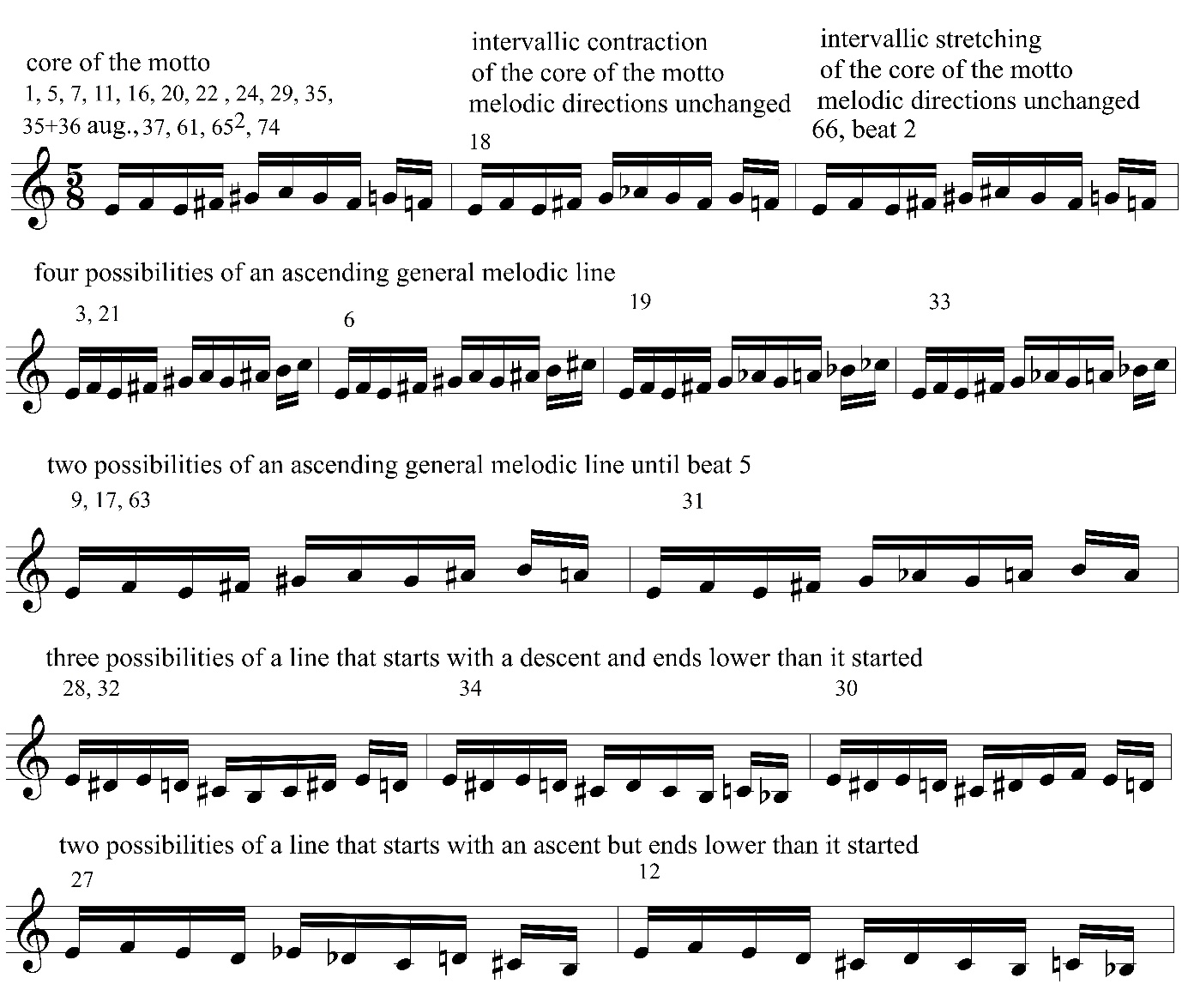
The version that opens the piece returns in its exact form no less than 14 times (one of which is augmented). In contrast, the many other formulations are unique or almost unique. I have arranged the different formulations of the theme according to general melodic directions. In fact, in all of the possibilities presented in the first row, there is the same exact series of ascents and descents (contour adjacency series): ascent-descent-ascent-ascent-ascent-descent-descent-ascent; all the options presented in the second row also share a contour class: in all of them there are eight different pitches, and if we were to ascribe a number to them, from lowest (0) to highest (7), regardless of the exact interval, we would get, from left to right, the same exact pattern (0102343567). The pattern in mm. 28 and 32 opens as an inversion to the motto, whereas in m. 12 the first three notes—and in transposition the six last notes—are identical to those of the motto, and only the connection between them is different.[17] In none of the different formulations of the motto of Summer Strings can we find a melodic leap, therefore the similarity of the different variants to each other is more pronounced than the shared melodic contour.
Also among the measures that follow the appearances of the motto in its exact original form there is a large number of variants, most of them unique (example 12). In all but one case (m. 30), the measures that follow the core of the motto start with the home note. At times there appears a variant that has already been heard in a measure that does not follow the core of the motto. For example, the variant in m. 21 is identical to the variant in m. 3. It is worth noting that there are no jumps in any of the variants, although in a number of them there is a whole tone that is notated as a diminished third.
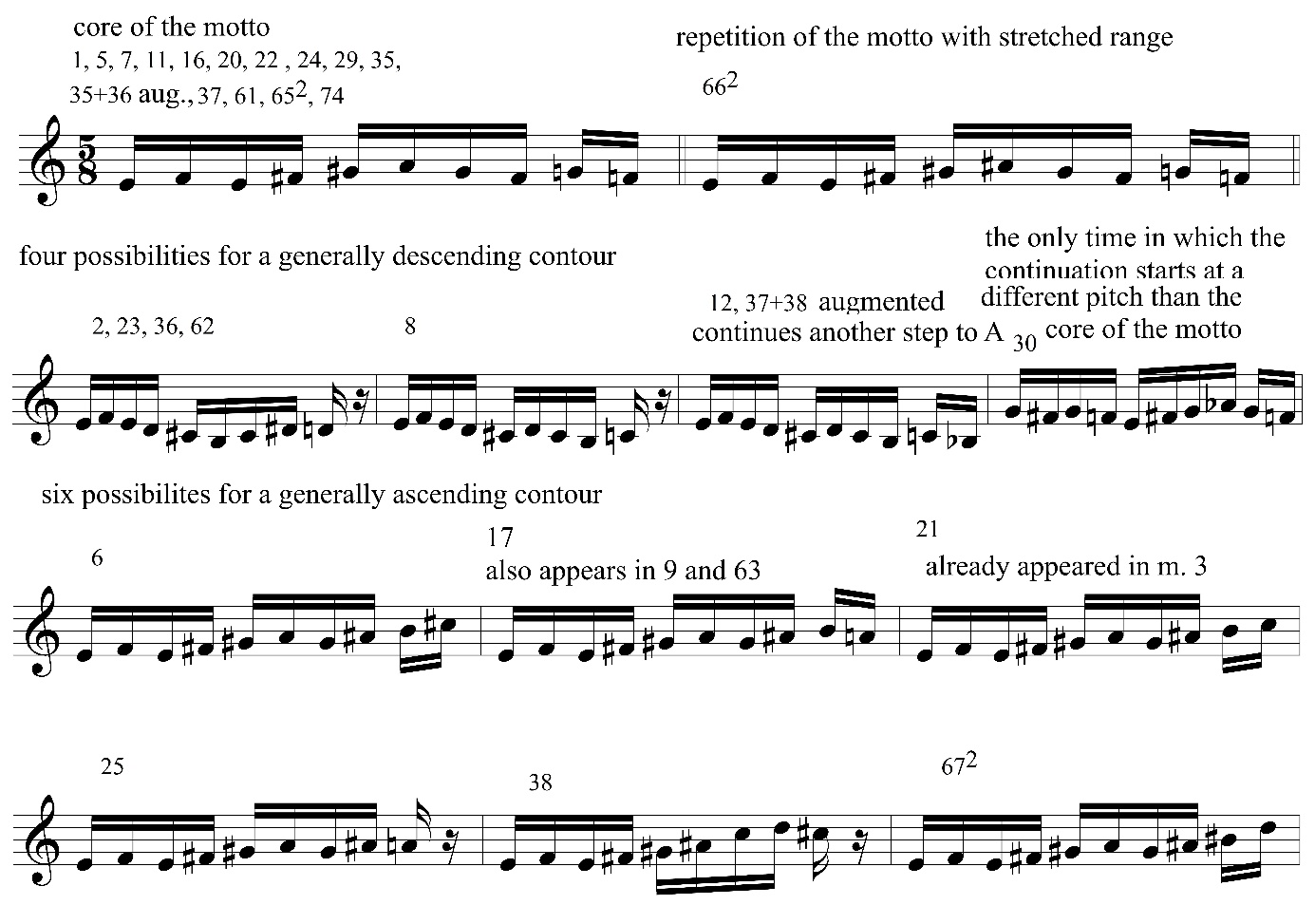
The first movement of Summer Strings blends together tonal and atonal elements in a successful and coherent way that is both close to the style of Bartók and distinctly personal. Avni did not return to this mixture later on. Additional research is required in order to establish whether and to what extent Summer Strings is compositionally close to Avni’s later works, in which he created a synthesis between his innovative style and tonal elements.
In Summer Strings, the yielding of the motto to contraction and to stretching and the yielding of the ascending contour pattern to four different variants show a flexible attitude in which major and minor seconds are interchangeable as long as the strive for chromatic filling subsists. Of course, this attitude is diametrically opposed to the dodecaphonic approach, in which intervals are meticulously kept intact and it is impossible to substitute a minor second with a major one. Maintaining a connection to the “Israeli” style, which is based on tonality and expanded modality, is far more challenging in a dodecaphonic piece such as Ödön Pártos’ Psalms String Quartet (1960).
# The intensification of the degenerate curl: The dodecaphonic curl in Ödön Pártos’s Psalms
With all its chromatic degenerations, the curling melody of Summer Strings always maintains its basic relation to a home note. In contrast, in Psalms, Ödön Pártos’s string quartet that predates Summer Strings, the chromatic curls are strung together in a dodecaphonic line. Dodecaphony is usually considered an “anonymous” writing style that is free from national stylistic attributes. However, the dodecaphony of the Psalms quartet sounds both modernist and, at least at times, Israeli. This was the intention of the composer, who later stated that he wanted to continue writing in the same style he composed in before moving to dodecaphonic writing.[18] The piece’s ability to maintain its connection to both worlds is a confounding theme that has been explored by Avner Bahat (whose commentary will soon be discussed) and Yohanan Ron.[19] Ron tries to explain this duality as the result of the characteristics of the chosen dodecaphonic row: the absence of large intervals; a gradually ascending contour; the dominance of the interval of a second (both major and minor); chromatic movement within the row (sometimes after a delay of a note or two, e.g. between the second and fourth notes); the division of the row into four three-note groups, in which every group is a short motive that sounds like it was taken from a traditional Middle Eastern canticle; and a structure that was constructed in such a way that the presence of the motives remains throughout all the transformations of the row. Example 13 presents the row on which Psalms is based. The bold numbers above the notes denote each note’s place in the row, and the numbers beneath the bold numbers denote the number of half tones between the notes and the note that opens the row. The numbers beneath the staff show the melodic interval (number of half tones) in the immediate progression. The chosen register realization is identical to the representation in Ron’s work, in which all the intervals are notated in their smallest possible realization, except for the motion back to the beginning of the row (which is realized as a perfect fifth, not a perfect fourth). In this realization, there are also notes beneath the opening note.

The “dominance” of the seconds in this row is questionable even when all the intervals in the row are realized according to the most minimal possibility, without turning the seconds into the complement interval of sevenths and without stretching them out with octaves into ninths. Minor and major seconds count for a third of the possible “interval classes” (ic)—two out of a possible six—and thus there are four seconds to be expected on average in a 12-tone series.[20] In the dodecaphonic row featured in Psalms there is only one more second than that: three times a half tone (ic1) and two times a whole tone (ic2). In the other seven immediate progressions, there are two progressions with a three-half-tone interval (ic3), two progressions with a four-half-tone interval (ic4), and three progressions with a five-half-tone interval (ic5), one of which is in the transition from the end of the row to its beginning. The ic6 interval (the tritone) is absent from the row.[21]
The division into three-note units is also problematic: the movement from the second note to the fourth, as Ron points out, is inconsistent with this kind of division. Additionally, the first two sets share the same set class (set class 014), while the remaining set classes are different (the third creates a 025 set class and the fourth creates a 024 set class). Thus, one cannot find regularity in the division into cells of three notes.[22]
It is possible that this Ron’s contentions originate from Pártos’s own comments on the row, in his conversation with Bahat, in which he associates the three-note units featured in the row with biblical cantillation.[23] It might be the case that three-note cells have the potential to relate to the cantillation, if the row is realized in a closed register and not always with a half-tone level of accuracy (i.e. without genuine presentation of the dodecaphonic material).[24] The cell “G-F-sharp-E-flat” (a realization of trichord 014) could sound, in a most distinct way, like an element from the “traditional eastern cantillation” when it is in a closed register, mainly with a tonal implication as augmented 4th and 5th steps on the basis of C as a central note or as steps 1, 7 as a leading note, and 6 as the basis of the central note G (and possibly as part of a Hijaz tetrachord with the addition of D). In contrast, on the basis of the central note E-flat, the resulting scale steps would be 1, raised 2, and 3, which could create associations with completely different stylistic frameworks. Example 14 shows a few tonal contexts for the trichord 014, alongside an excerpt from the second movement of Psalms, in which the Trichord is realized in an “Israeli-Eastern” context (without accompaniment), clearly due to the realization of the material rather than merely to the material itself. It is important to note the closed and convening contour and, especially, to compare the four last notes in the melodic line to notes 6–9 in the motto of Summer Strings.
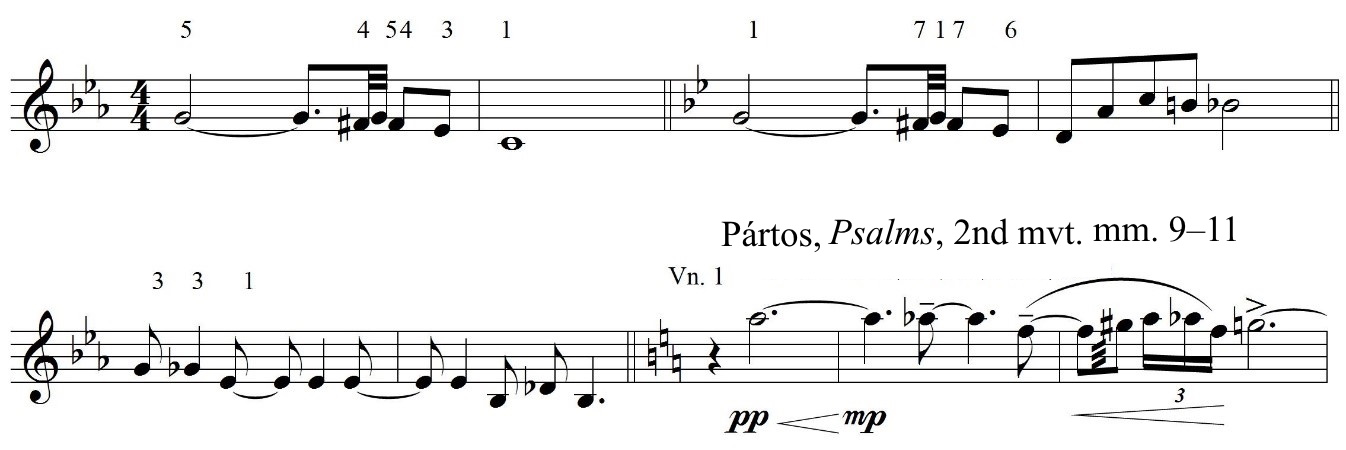
It is worth noting that the dodecaphonic row is flexible material from which it is possible to accentuate different potential components. In example 15, different realizations of the complete row are displayed, realizations which accentuate different components from the ones cited by Ron: the first realization accentuates the leaps rather than the steps, while the second creates implicit polyphony, in which two lines move in opposite directions (F-sharp-E-D in the upper register; G-G-sharp-B-flat in the lower register).[25]
It is worth noting that the dodecaphonic row is flexible material from which it is possible to accentuate different potential components.
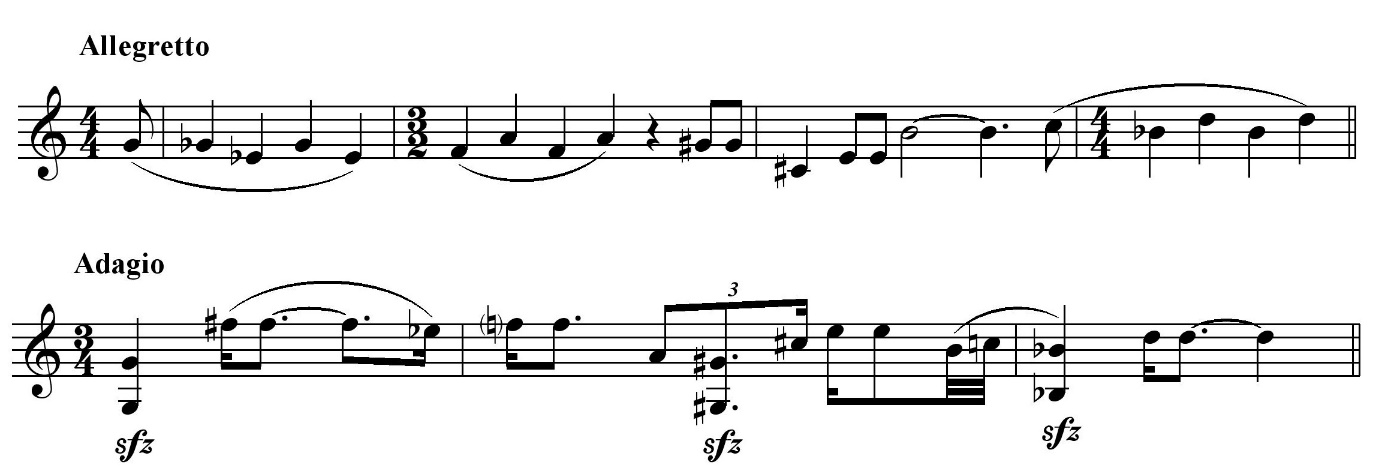
Additionally, it is worth noting that these realizations too are melodic in essence. Example 16 will show that the “Israeli” nature of Psalms does not depend on the identity of the row. In this example, the dodecaphonic row of Psalms is transplanted into the beginning of Webern’s String Quartet Op. 28 (instead of the original row).[26] In general, Webern’s style avoids register continuity. Thus, out of the five occurrences of ic1 or ic2, only one is realized in this example as a second, whereas the rest are realized as sevenths or ninths. Beyond this, it features no melodic successions, a sense of hierarchy of meter, or continuity in the same instrument.[27]

There is no doubt, therefore, that the identity of the row does not determine the “Israeli” potential of the dodecaphonic work, for it is the realization that creates the “traditional” feeling (first of all in the sense of the tradition of Western tonal music, and perhaps then also in relation to the tradition of the Jewish communities). This is also the view held by Bahat, who lists the different components through which Psalms creates Pártos’s personal style. First, he cites two places in which Pártos diverges from strict dodecaphonic writing. According to Bahat, “Pártos doubles octaves on notes according to his choice… thus creating a pronounced inequality between the sounds; he repeats single notes, especially combinations of sounds taken from the row before the entire row is completed, and he does this in a motive-based way that accentuates his melodic attitude toward the row and its parts.”[28] As a matter of fact, according to the principles of dodecaphony in their strict form, immediate repetitions of tones and of pairs of tones in trills or tremolos are allowed.[29] As for doubling notes through octaves, while Schoenberg demanded to avoid such doublings in order to avoid the accentuation of any particular sounds[30], in his late dodecaphonic pieces he himself transgressed this rule.[31] But it is unclear whether the doublings at the beginning of Psalms are an important component in the style of Pártos and a significant key to understanding the traditional elements of the realization of dodecaphony in his work. The first note of the row in Psalms is indeed doubled at the beginning of the piece. Yet this moment still sounds exceptionally dissonant and harsh.
We will now turn to an examination of the moments that are seen as “Israeli,” by Bahat, others and myself and others. Bahat discerns Israeliness in diverse and even contrasting moments throughout the piece. On the one hand, he points out recitative-like parts.[32] Additionally, he declares that the rhythmic components too are fit to help assess the “Israeli” nature of the piece (for instance, the lack of meter, perhaps under the influence of Middle Eastern music).[33] On the other hand, in his next examples Bahat chooses completely different moments from the piece to illustrate the style (excerpts based on imitation patterns, most of which feature moderate rhythmic values). Thus, it is possible to conclude that a different concept of “Israeliness” was guiding Bahat in his choice.
At its best moments, the imitative writing in Psalms incorporates all the voices in the construction of the row.[34] The “Israeli” feeling in the imitative passage is perplexing. Not only is canonical imitation a learned Western technique, but it does not relate to Western exoticist representations of the East.[35] That being said, it is possible to find in the imitations of Psalms a style that is definitely related to the “thesis” music in the sense discussed at the beginning of this discussion.
First, we will examine a moment that includes an inexact imitation of a melodic excerpt that features an ornamental curl (example 17), which is also close to the recitative family. The ornamental curl is generated here by an immediate and fast repetition of two sounds with a minor second interval between them and with a closed realization (this is the continuation of a phrase that begins in m. 92). The imitation here showcases the compositional treatment given to the row: each one of the instruments plays a row of its own. The cellos and violas play inversions of the row in different transpositions, while the second violin answers them with an inversion based on the primary form of the row.[36] The imitation is not exact, but the registral realization of the intervals stays exact in all the voices, and the characteristic rhythm in thirty-second notes does not change, even though it changes its place in the measure.
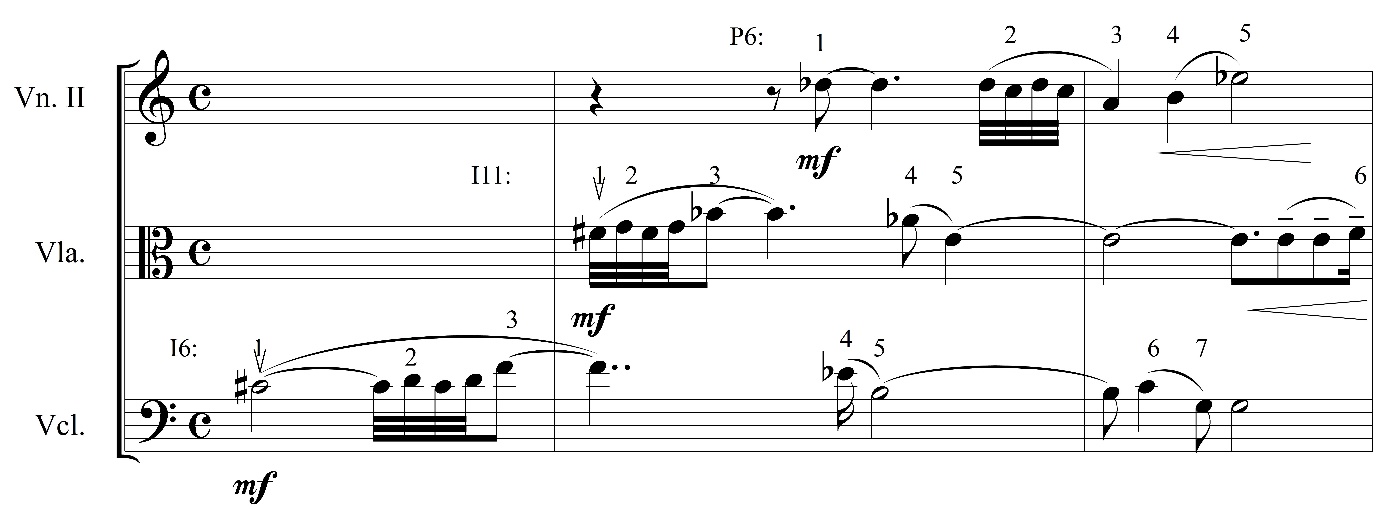
A clear moment of imitation stands out at the beginning of the fast section of the first movement (example 19). Here too the beginning of the imitation originates from the simultaneous existence of two rows: the primary row played by the first violin and transposed by five half tones (P5) and an inversion that begins a whole tone lower (I10) in the rest of the instruments. And yet the continuation of the imitation is based on pairs of seconds at the beginning of the row. It is worth noting that here we can see the second that Ron tried to find in the row itself in the specific realization of the row: the simultaneous use of the primary form and of the inversion of the row enables the doubling of the amount of seconds from three (between the first note of the row and the second, between the third note and the fourth, and between the fifth note and the sixth) to six. The imitation is not based on the common interval alone, but also on its rhythmic realization and closed register. The minor second and the major second are used for the imitation of a single motive without distinction.[37]
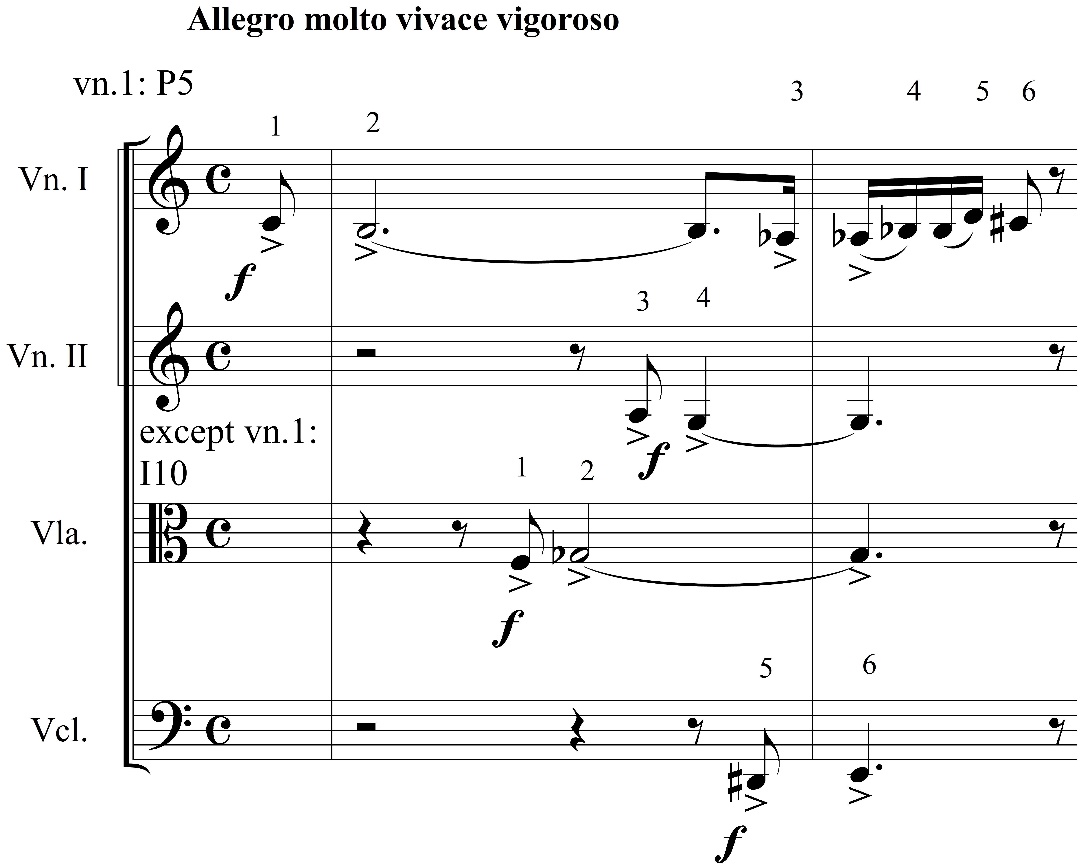
The traditional understanding of the motive works even when the intervals that are imitated do not belong even to the expanded interval class that binds together minor and major seconds. In example 19, the first violin once again plays one realization of the row (in retrograde), while the other instruments share a different realization of the row (in retrograde inversion).[38] The opening imitation realizes this inversion relation as a de-facto motivic imitation. And yet the subsequent entrances sound like traditional imitations despite the difference in the intervals (a minor second in the second violin, a minor third in the viola) only due to the rhythm (a short two-note upbeat, like in a Gavotte) and the repetition of the note in the upbeat. The chromatic ending in the next measure is not dependent on a progression in the row: after a repetition of the tetrachord that opens the retrograde inversion, the subsequent note, A-flat, is intentionally realized in another voice simultaneously in order to reach the following note in the row, B natural. The need for this skip shows that the dodecaphonic line at this moment is not a compositional tool that serves the composer, but rather a burden for him. The wish to lead to B natural is the result of its being a missing chromatic note in the dense tetrachord that precedes it. The drive for this choice lies in a realization of the row that is effectively in a closed register. The closing succession, D-C-D-flat-B, is identical (in transposition) to the four last notes in the core of the motto of Summer Strings. Here too the immediate context in the melody creates the potential for the implication of a scale as two variants, of scale-steps 3 and 2 alternately (against the B-flat), but unlike in Summer Strings, the general context does not support this scale interpretation.
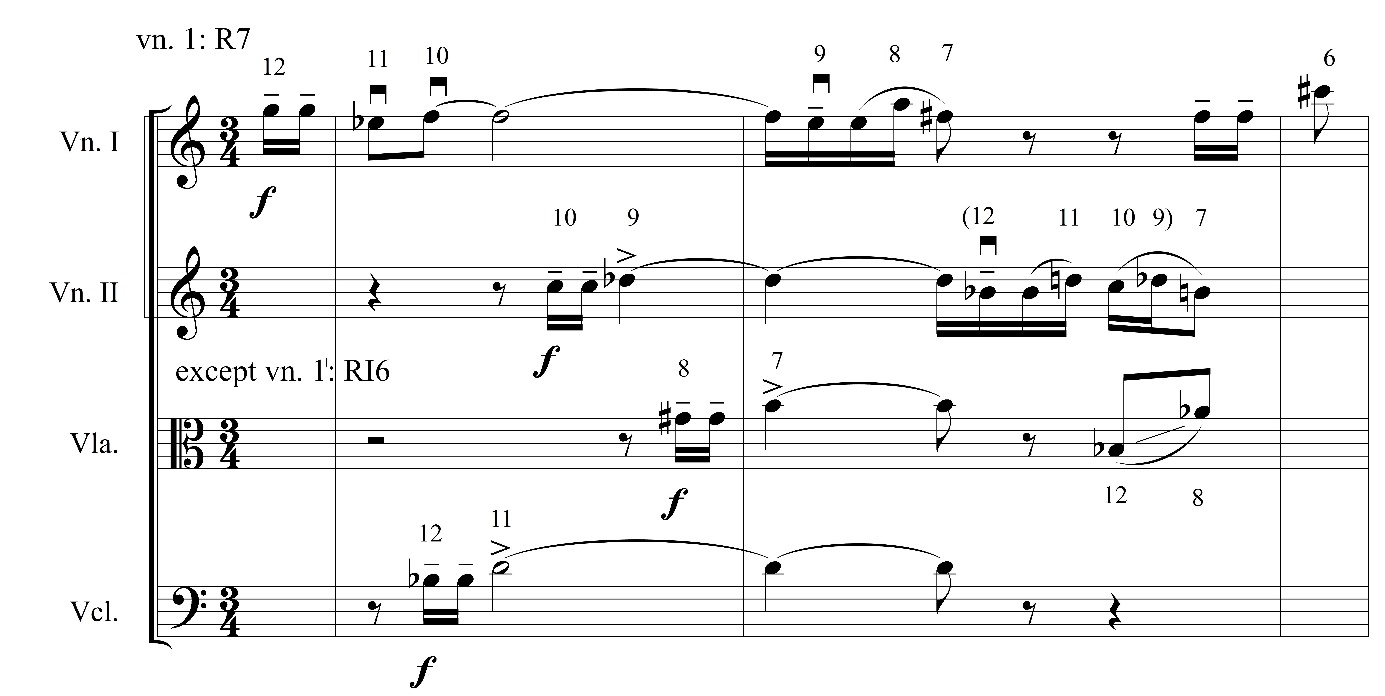
The ruse of sending the eighth note of the row to another voice occurs again in another imitative excerpt (m. 153, example 20), in which all the entrances are in pairs of notes in stepwise proximity. This time, the notes belong to a shared row played in a traditional motivic canon in a descending fan. Once again, it seems that Pártos struggles with the raw material of the row in order to get a traditional motivic feeling with the aid of seconds (and without distinguishing between the types of seconds, which supposedly should have been of vital importance in dodecaphonic writing). Another struggle with the row can clearly be seen in the violins in m. 174 (example 21, the viola and the cello end an earlier row), in which even the order of the notes is not kept in an exact way. The reasons for the diversion from the order of the row are once again the creation of second-based relations between notes that are far from each other in the row: notes 1 to 6 and notes 3 to 8 (on subsequent strong beats). The motives that result from the two tetrachords (notes number 1, 2, 5, and 6 in the row against notes number 3, 4, 7, and 8) create an inversion that has a motivic link to the last tetrachord in its original order (notes number 9–12 of the row). The resulting motive does not maintain neither a steady contour in the inversion nor accuracy on the half-tone level, and it points to a traditional motive-minded conception rather than dogmatic dodecaphony.[39]
The ruse of sending the eighth note of the row to another voice occurs again in another imitative excerpt (m.
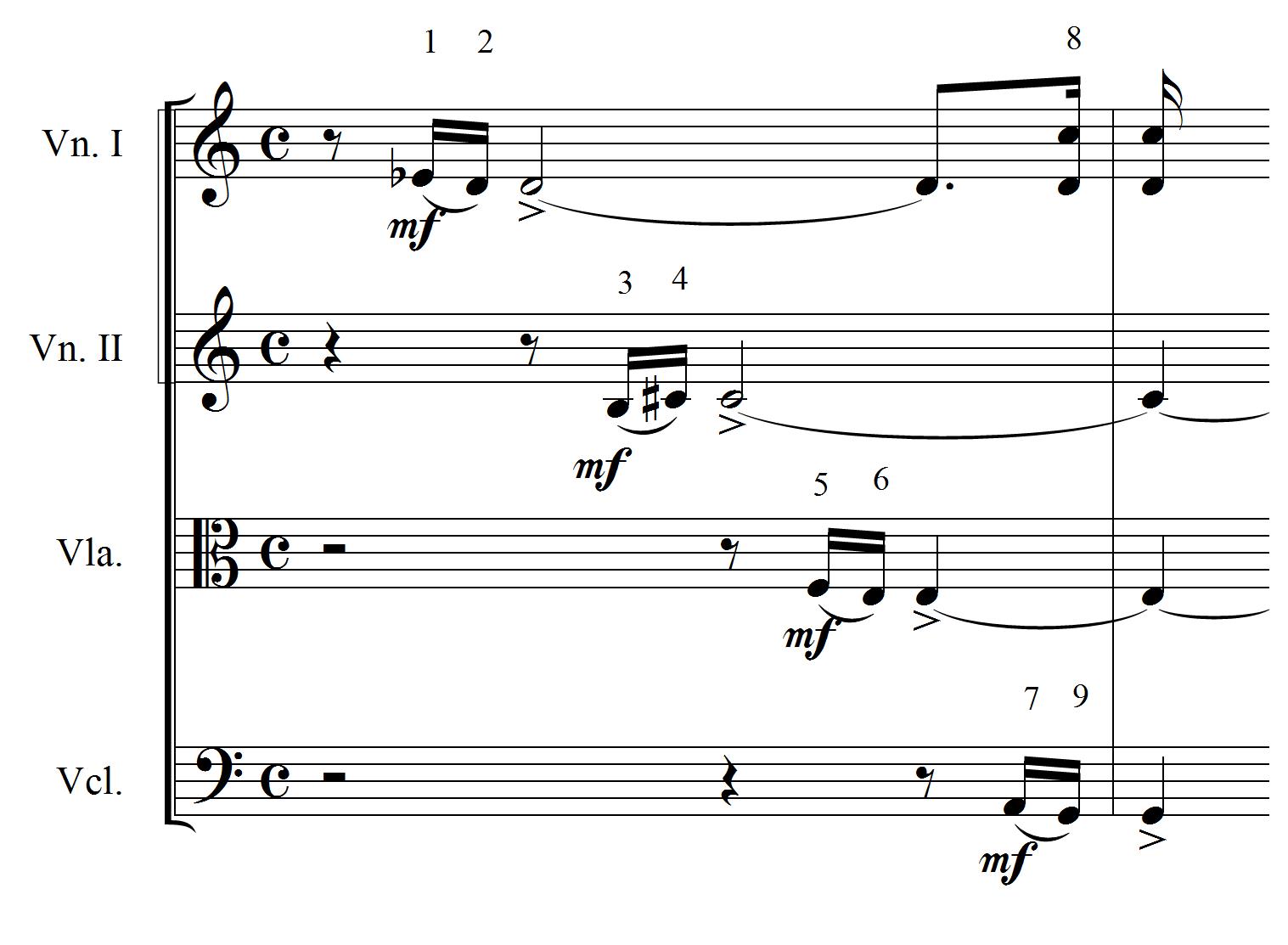

It turns out that the accentuation of the seconds in the row is a valid tool in most of the “Israeli” moments, although not in all of them. The use of the components of the row only in a closed register does a lot to bring their realization closer to the spirit of the “thesis.” This is especially true in the case of the opening tetrachord, which is realized in moments like the one in the example above with a curling contour (in a different manner from curls that are the result of repetitions of notes).
Based on this analysis, it is possible to better appreciate the interpretation that Psalms is a work that preserves Israeli components. Bahat delivers as is the explanations of the composer regarding the presence of the cantillations in melodic cells in the piece, even when the melodic cells in themselves are small and almost neutral. Additionally, he tends to interpret the spirit of “Israeliness” in contrasting segments: both in a slow recitative and in a contrasting fast fugato (and he even links the “alternation of fast and short movements” to “certain structures in Middle Eastern music”).[40] Bahat writes that “Pártos managed to connect in his work Psalms two musical worlds that upon first glance seem irreconcilable.”[41] In writing this, Bahat gives the work a positive assessment. A critical examination of this assessment could see it as going beyond aesthetic judgment, under the influence of a more general positive attitude toward the ideas of the “gathering of the exiles” and the return of the people of Israel to its motherland. It seems as if an admission regarding the work’s Western nature would be tantamount to an acknowledgement that the people of Israel are a foreign element in the Middle East and would undermine our right to the land of Israel.
And yet further examination of the Psalms quartet itself shows a large number of moments which sound like the music of the “thesis” period. The identification of the “thesis” music as “Israeli” predates the Psalms quartet, and this needs to be accepted as given in order to discuss the work. The moments that sound like the “thesis” music are, without a doubt, different from most of the tonal allusions in dodecaphonic music literature, which are based on triadic chords.[42] It is more challenging to compare such moments to the few moments in non-Israeli dodecaphonic works that could sound in our biased years as “Israeli-isms.” Example 22 shows one such moment. The diatonic-like progression is enabled due to the dense chords that include the rest of the row.

An approach that does not attribute much importance to the intentions of the composer would allow ears that are well-versed in the music of the “thesis” period to associate with it any modal-diatonic moment with a step-based closed contour, like the excerpt cited above from Schoenberg’s Piano Concerto. And yet this approach¬—which enables, by its very nature, different associations among different listeners—needs to also acknowledge that for listeners who were brought up on the cantillations (like Pártos and Avner Bahat) any combination of notes that resembles them would be received as reminiscent of them in a true and non-artificial way.[43]
The legitimacy for individual listening horizons exemplifies a postmodern influence, but a lenient attitude toward different interpretations has its limits. The existence of Israeli-like moments in world music literature does not need to dissuade us from trying to understand their nature in depth. The “Israeliness” of the Psalms quartet reflects specific compositional choices taken among the possibilities inherent to dodecaphonic technique, and even distinct from other possibilities of allusion to tonal music. Together with its being dissonant and dodecaphonic, in specific (but very pronounced) moments, Psalms shows a clear connection to expanded modal music that is characteristic of, among other things, first-generation Israeli art music. This phenomenon is, in itself, fascinating to listen to and study.
The works which were discussed here are worthy of fundamental and detailed analysis, which is intended to deepen our understanding of them as individual works of art, to promote research of the development of Israeli art music, and, just as importantly, to contribute to the understanding of the interplay between expanded tonal music and atonality in a global perspective.
# Notes
[1] Ronit Seter, Yuvalim be-Israel: Nationalism in Jewish-Israeli Art Music, 1940–2000, PhD Diss., Cornell University, 2004, p. 152
[2] Yosef Goldenberg, “‘Israeli’ Moments in Foreign Music,” a paper that was to be given at the 16th International World Congress of Jewish Studies, 2013. Full text available at: www.jewish-music.huji.ac.il
[3] See for example Liora Bresler, “The Mediterranean Manifests in the Musical Style in Israel,” in Cathedra 38 (Hebrew): 137–160.
[4] Yosef Goldenberg, “Nationality, Modernity, and Truth in Israeli Music,” in Tav Plus 13 (2009) (Hebrew): 20–22
[5] Michael Wolpe, “The Dream of the Broken Mirror,” in Tzvi Avni, In a Personal Pulse: Life Chapters in Music (Maba: Kefar Sava, 2012): 11–21 (Hebrew)
[6] Avni 2012, p. 52
[7] Ibid. I must qualify this statement. Impressionism, as I understand it (in the sense the term is commonly used, usually in reference to the style of Debussy) is not particularly close to the style of the melodic and folkloristic Mediterranean School (although Paul Ben Haim incorporated impressionistic elements in works such as his Pieces for Piano Op. 34) but is actually a precursor of “sonoristic” thinking.
[8] See: William E. Caplin, Classical Form: A Theory of Formal Functions for the Instrumental Music of Haydn, Mozart and Beethoven, Oxford: Oxford University Press, 1998, pp. 35–48
[9] See the analysis of Beethoven’s Sonata Op 81 No. 2 (mm. 15–21) in: Mark Richards, "Viennese Classicism and the Sentential Idea: Broadening the Sentence Paradigm,” Theory and Practice, 36, (2011): 179–225, esp. pp. 208–209.
[10] In the absence of functional harmony, the reasons for the sense of a central note are a controversial theoretical issue. From the seven factors that Tymoczko lists (2011, p. 179) as causes for the sense of a central note, only one (stressed meter) is applicable to Summer Strings. In this piece, the first accented note also starts the second measure, and all the beats in the first measure start with this note or with notes that are consonant with it. For Tymoczko’s discussion see: Dmitri Tymoczko, A Geometry of Music: Harmony and Counterpoint in the Extended Common Practice, Oxford: Oxford University Press, 2011
[11] Eitan Agmon finds examples of this phenomenon in Bartók’s Music for Strings Percussion and Celesta. See: Eytan Agmon, The Languages of Western Tonality, Berlin: Springer 2013, pp. 84–85.
[12] Johnson, Timothy A., "Chromatic Quotations of Diatonic Tunes in Songs of Charles Ives,” Music Theory Spectrum 18/2: 236–261
[13] The Diatonic system is based on seven notes in an octave. Equal divisions of the octave into three or four are partial versions of, correspondingly, six-note scales (the whole-tone scale) or eight note scales (the octatonic scale).
[14] An Insect hum is a “topos” (a kind of musical idiom with an extra-musical association) on an onomatopoeic basis. The term “topos” in a musical context was coined by Leonard Ratner in reference to music of the Classical period. See Leonard G. Ratner, Classic Music: Expression, Form, and Style New York: Schirmer, 1980, p. 9. On numerous occasions, when a topos appears in 20th century music, it is a distortion of a traditional topos (as it is in the distorted waltz in Alban Berg’s opera Wozzek). The insect topos actually fits better with dissonant music, as in tonal music it might generate compositional difficulties. For an example, listen to Mendelssohn’s Song without Words Op. 67 No. 4, a “Spinning Song” which, to my understanding, clearly represents the weaving of spider webs. Of course, in Summer Strings the extra-musical imagery is but a listening option.
[15] A similar situation occurs in Bartók’s 33rd duet for two violins (m. 1 in contrast to m. 30). See the analysis in Andrew Mead, "Shedding Scales: Understanding Intervals in Different Musical Contexts,” Theory and Practice 22/23 (1997/98): 79. For a more general discussion of different scale-based ways of counting the same absolute intervals see Tymoczko, pp. 116–132. Additionally, see Steven Rings, Tonality and Transformation, Oxford: Oxford University Press
[16] The English term “curl” [for the Hebrew Silsul] is not common in relation to music. It designates the zig-zag and mainly stepwise contour, often but not necessarily ornamtental. In order to understand how an ornamental curl develops into a directional scale movement, see the introduction to the last movement of Dvorak’s New World Symphony: the movement of seconds, first a minor second and then a major second, initially sounds like variants of the ornament, but it quickly turns out that it is a scale movement against an organ point. I must qualify the equivalence by saying that the opening of the ornamental curl in Summer Strings is not that schematic.
[17] For an elaborate explanation of the concepts ‘contour class’ and ‘contour adjacency series,’ see Michael L. Friedmann, "A Methodology for the Discussion of Contour: Its Application to Schoenberg's Music,” Journal of Music Theory 29/2 (1985): 223:48. In the first row, the version in m. 66, in which the intervals are stretched, is identical in its ‘contour class’ to the version in m. 1, but the version in m. 18 is different, because the fifth and the seventh notes are identical to the ninth note and are not higher than it. It is possible to quantify the difference using a contour matrix (the contour similarity index) in which the melodic contour of every note is checked against every note in the melodic row. In Summer Strings, the difference between mm. 1 and 18 occurs in only two data pieces (the relation of the fifth note to the ninth and of the seventh note to the ninth) out of 45 (giving it a 95.5% similarity score). Elizabeth Marvin’s ‘contour matrix’ is explained clearly in Ian Quinn, "Fuzzy Extensions to the Theory of Contour,” Music Theory Spectrum 19/2 (1997): 241.
[18] Ödön Pártos, interview with Avner Bahat (Hebrew; no date specified), available for listening at the website of Israel’s National Library, shelf number Y09651, first reel (www.nli.org.il), starting time: 3:00.
In the interview, Pártos also lists in detail the sections of the movement, based on the expanded Rondo Sonata form. Here I will avoid commenting on the formal analysis, which is not entirely convincing and is not related to our discussion.
In the interview, Pártos also lists in detail the sections of the movement, based on the expanded Rondo Sonata form.
[19] Avner Bahat, Ödön Pártos: His Life and Work (Am Oved, 1984) (Hebrew), pp. 205-216; Yohanan Ron, “Expression of the twelve-tone row in the works of Oedoen Partos and Josef Tal,” Orbis Musicae 11 (1993–1994), p. 82.
[20] An “interval class” includes all the intervals with a specific number of half tones, including the intervals that complete them into an octave or are constructed with the addition of an octave. For instance, interval class 1, or ic1, includes a minor second; its complement, a major 7th; a minor ninth (a minor second + an octave); and these intervals together with the addition of more octaves. Altogether, there are six groups of intervals, which in their simplest and most closed realization can be listed as a minor second, a large second, a minor third, a major third, a perfect fourth and a tritone. A perfect unison or an octave could also be treated as a seventh interval class, but it is not a series of intervals that can be used in dodecaphonic rows.
[21] It is worth noting, in comparison, that Webern’s works have a truly exceptional occurrence rate of ic1. As one of six options, the expected average occurrence is two in a row of 12 tones, but this interval class appears in at least four successions in 17 out of 22 rows of Webern’s dodecaphonic works (and in at least five progressions in 11 of the rows). See Kathryn Bailey, The Twelve-Note Music of Anton Webern, Cambridge: Cambridge University Press, 1991, p. 13.
[22] The numbers denote half-tone intervals. For instance, the 025 set class in reference to C would include, in addition to C, the notes D (two half tones above C) and F (five half tones above it). The inversion of the set class is normally regarded as equivalent to the same class. For a systematic introduction to set-class theory see Joseph Straus, Introduction to Post-Tonal Music, 3rd ed. Upper Saddle River, NJ: Prentice Hall, 2005
[23] Bahat, Ödön Pártos, p. 210. In p. 209 Bahat mentions that “the cantillations are some of the composer’s earliest musical memories.” This probably refers to Ashkenazy cantillations rather than the “eastern cantillations” that Ron cited. Tzvi Avni has also written (In a Personal Pulse, p. 52), based on a conversation with Pártos, that “in those days [the beginning of the 1960s] Pártos was already working with dodecaphony and with the series of sounds that he would use in his work. He also tried to incorporate in them elements of the cantillations and of the Eastern Maqams. One of the most successful results of these combinations is his second string quartet, Psalms, from 1960.” In the audio interview mentioned above (10:40), Pártos finds a resemblance to the cantillation in m. 40 of the first movement of Psalms.
[24] The scholar of Ashkenazi liturgical music Amalia Kedem discerns, in a correspondence with me, a full identity to the cantillations only in the third and fourth three-note units (accordingly, a Mercha before a Tevir and Etnaḥta, according to the cantillation of Ruth, Ecclesiastics, and the Song of Songs). In the first three-note unit she discerns a motive that is close in its form to the Zaqef of the cantillations of Song of Songs, Ruth, and Ecclesiastics, but with a contour that is diminished by half a tone in the first interval (the exact combination would have been G–F–D); in the second three-note unit she discerns a motive close in its form to a Munaḥ before Telisha, a Munaḥ before Pazer, and a Munaḥ before Zarqa, but in the exact motive the G needs to be natural and not sharp. According to these identifications, the cantillations are more diatonic than the melodic cells that are close to them.
.
[25] In Psalms, there are realizations that accentuate the thirds, such as in m. 58 of the first movement (Bahat’s example).
[26] Webern’s work is also dodecaphonic. Mm. 4 and 5 are originally played by the second violin.
[27] In fact, the breaking of registers neutralizes the potential traditional components of a dodecaphonic row. While the composer Yinam Leef did use a row in a piece with an “Israeli” title—Canaanite Fantasy No. 1 for Piano—in practice the Canaanite component (a potential ornamental curl) was erased because of the fantasy element (the breaking of registers).
[28] Bahat, Ödön Pártos, p. 205, following Pártos’s remarks at the beginning of the interview with him (see footnote 17).
[29] Josef Rufer, Composition with Twelve Notes Related Only to One Another, (trans.) Humphrey Searle, London: Barrie and Rockliff, 1954 [originally in German, 1952], pp. 87–90
[30] Arnold Schoenberg, “Composition with Twelve Notes” (1), in: Style and Idea: Selected Writings of Arnold Schoenberg, (ed.) Leonard Stein, (trans.) Leo Black, London: Faber & Faber, 1975, p. 228
[31] George Perle, Serial Composition and Atonality: An Introduction to the Music of Schoenberg, Berg, and Webern, 3rd ed., Berkeley: University of California Press, 1972, p. 105
[32] “In m. 20 there begins a development of short, 2–4 note motives. These motives, largely due to the accented recitative-like rhythm, is reminiscent of the cantillation” (Bahat, Ödön Pártos, p. 209)
[33] “1. The ornamental curls, which are the main reason for repetitions of parts of the row; 2. The appearance of very short notes alongside very long notes, which accentuates the contrast between them; 3. The short notes usually come before the long ones. This technique is very characteristic of Ödön Pártos, and it might very well originate in the rhythm … which has its accent on the penultimate syllable like Pártos’s native Hungarian language. This might have been inspired by Bartók and Kodaly.” (Ibid. p. 207) Bahat wrongly mentions “the iambic stress of the penultimate syllable,” whereas the two-note rhythm with a penultimate accent is by definition trochaic, be the relations between the notes as they may.
[34] Imitative writing in general supports an equal texture, which in a dodecaphonic work has the potential to include all the textural layers in the construction of the row. In comparison, Schoenberg’s 4th String Quartet opens with a melody and accompaniment. The row is very clear in the melody of the first violin, but in the accompanying chords it is extremely difficult to follow the details of the specific dissonances that result from the row.
[35] Normally, the texture that is considered to be most characteristic of Israeli writing is a rather simple one (unison or ostinato). See Bahat’s research, Musical Elements from Diasporic Traditions in Israeli Art Music (A Discussion of 10 Selected Works), MA Thesis, Tel Aviv University, 1973 (Hebrew). According to Carl Dahlhaus, organ points and empty textures also characterise folklorism and exoticism on a global perspective. See Carl Dahlhaus, Nineteenth-Century Music, (trans.) J. Bradford Robinson, Berkeley: University of California Press, 1989 [in German: 1980], p. 306; Ralph Locke, Musical Exoticism: Images and Reflections, Cambridge: Cambridge University Press, 2009, pp. 51–54.
[36] Of course, in each dodecaphonic row there are 48 possible realizations: the 12 transpositions of each one in four forms: Primary (P) Inversion (I), Retrograde (R) and Retrograde Inversion (RI). The digit to the right of the letter represents the transposition (between 0–11). In the notation system we shall use here, the transposition of the retrograde and of the retrograde inversion will be determined by the last note, which is the first note of the primary row and of the inversion.
[37] The line played by the first violin in this excerpt serves as a part of example 3 in Bahat’s analysis. A similar moment occurs in mm. 113–114: the first violin plays an inversion that starts from the note A (I2), and the rest of the instruments play the primary form starting from the note E (P9). This excerpt is only partially imitative, and yet one can still hear six melodic seconds instead of three because of the double rows.
[38] This excerpt (without the marks of the numbers of sounds in the row) serves as part of example four in Bahat’s analysis.
[39] The moment cited in example 21 is a very similar to a moment in String Quartet No. 1 by Josef Tal (1959) (movement 1, m. 32). There too an imitation in seconds moves between the instruments (the cello does not participate in the imitation); there too the long notes are the destination notes in every second; and there too there is a mix of major and minor seconds. The imitation in Psalms uses a melodic inversion that is absent from the moment of imitation in Tal’s work. The use of inversion is a characteristic attribute of dodecaphonic rows, but it is, of course, not limited to them.
[40] Bahat, Ödön Pártos, p.214
[41] Ibid.
[42] See for example the famous segment in mm. 11–14 of the first movement of Alban Berg’s Violin Concerto. This excerpt and other relevant ones are discussed in Joseph N. Straus Remaking the Past: Musical Modernism and the Influence of the Tonal Tradition, 1990, Cambridge, Mass.: Harvard University Press. The book features an extensive discussion (pp. 74–95) of allusions to triadic chords, but not of scale-based segments. For a discussion of “directed motion” in clearly atonal music see Roy Travis, "Directed Motion in Schoenberg and Webern,” Perspectives of New Music 4/2 (1966), pp. 85–89.
[43] For an approach that underplays the importance of the composer’s intension, according to which ”interpretative problems cannot be solved by consulting the composer,” see Goran Hermeren, “The Full Voic’d Quire Types of Interpretation in Music,” in: The Interpretation of Music: Philosophical Essays, (ed.) Michael Krausz, Oxford: Clarendon Press, 1993, p. 17. For an approach that accepts allusions on an individual and even anachronistic basis see Christopher Alan Reynolds, Motives for Allusion: Context and Content in Nineteenth-Century Music, Cambridge, Mass.: Harvard University Press, 2003, p. x. Reynolds illustrates anachronistic associations in identifying the motto of Beethoven’s Fifth Symphony in a piece for organ by Buxtehude.